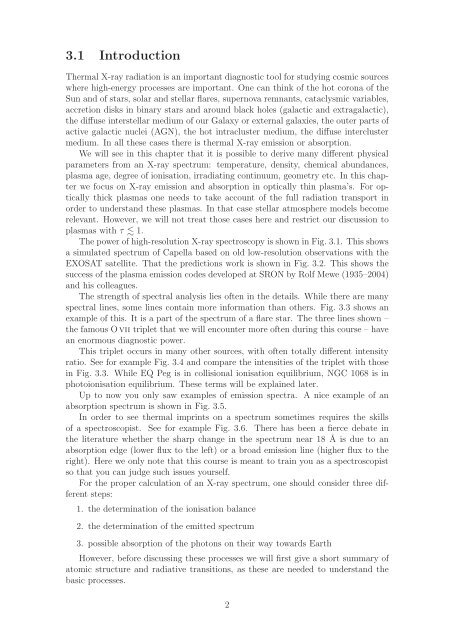Thermal X-ray radiation (PDF) - SRON
Thermal X-ray radiation (PDF) - SRON
Thermal X-ray radiation (PDF) - SRON
You also want an ePaper? Increase the reach of your titles
YUMPU automatically turns print PDFs into web optimized ePapers that Google loves.
3.1 Introduction<br />
<strong>Thermal</strong> X-<strong>ray</strong> <strong>radiation</strong> is an important diagnostic tool for studying cosmic sources<br />
where high-energy processes are important. One can think of the hot corona of the<br />
Sun and of stars, solar and stellar flares, supernova remnants, cataclysmic variables,<br />
accretion disks in binary stars and around black holes (galactic and extragalactic),<br />
the diffuse interstellar medium of our Galaxy or external galaxies, the outer parts of<br />
active galactic nuclei (AGN), the hot intracluster medium, the diffuse intercluster<br />
medium. In all these cases there is thermal X-<strong>ray</strong> emission or absorption.<br />
We will see in this chapter that it is possible to derive many different physical<br />
parameters from an X-<strong>ray</strong> spectrum: temperature, density, chemical abundances,<br />
plasma age, degree of ionisation, irradiating continuum, geometry etc. In this chapter<br />
we focus on X-<strong>ray</strong> emission and absorption in optically thin plasma’s. For optically<br />
thick plasmas one needs to take account of the full <strong>radiation</strong> transport in<br />
order to understand these plasmas. In that case stellar atmosphere models become<br />
relevant. However, we will not treat those cases here and restrict our discussion to<br />
plasmas with τ 1.<br />
The power of high-resolution X-<strong>ray</strong> spectroscopy is shown in Fig. 3.1. This shows<br />
a simulated spectrum of Capella based on old low-resolution observations with the<br />
EXOSAT satellite. That the predictions work is shown in Fig. 3.2. This shows the<br />
success of the plasma emission codes developed at <strong>SRON</strong> by Rolf Mewe (1935–2004)<br />
and his colleagues.<br />
The strength of spectral analysis lies often in the details. While there are many<br />
spectral lines, some lines contain more information than others. Fig. 3.3 shows an<br />
example of this. It is a part of the spectrum of a flare star. The three lines shown –<br />
the famous Ovii triplet that we will encounter more often during this course – have<br />
an enormous diagnostic power.<br />
This triplet occurs in many other sources, with often totally different intensity<br />
ratio. See for example Fig. 3.4 and compare the intensities of the triplet with those<br />
in Fig. 3.3. While EQ Peg is in collisional ionisation equilibrium, NGC 1068 is in<br />
photoionisation equilibrium. These terms will be explained later.<br />
Up to now you only saw examples of emission spectra. A nice example of an<br />
absorption spectrum is shown in Fig. 3.5.<br />
In order to see thermal imprints on a spectrum sometimes requires the skills<br />
of a spectroscopist. See for example Fig. 3.6. There has been a fierce debate in<br />
the literature whether the sharp change in the spectrum near 18 Å is due to an<br />
absorption edge (lower flux to the left) or a broad emission line (higher flux to the<br />
right). Here we only note that this course is meant to train you as a spectroscopist<br />
so that you can judge such issues yourself.<br />
For the proper calculation of an X-<strong>ray</strong> spectrum, one should consider three different<br />
steps:<br />
1. the determination of the ionisation balance<br />
2. the determination of the emitted spectrum<br />
3. possible absorption of the photons on their way towards Earth<br />
However, before discussing these processes we will first give a short summary of<br />
atomic structure and radiative transitions, as these are needed to understand the<br />
basic processes.<br />
2
















